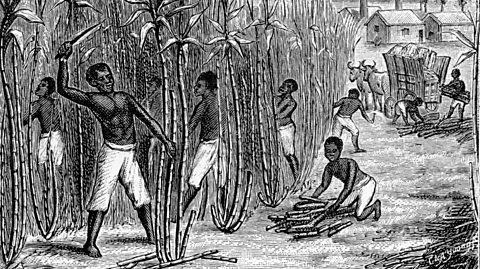The trade in enslaved people and the effects on West Africa
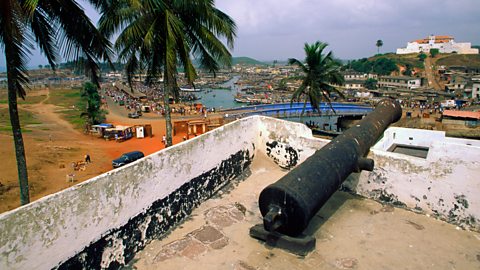 Image source, ALAMY
Image source, ALAMYQuick version
- Slavery had existed in African societies before European arrival.
- Demand for enslaved labour from Europeans turned the trade in captured Africans into a huge industry.
Captured Africans were traded for in-demand European goods such as:
- guns
- brandy
- textiles
- jewellery
The trade in captured Africans had a devastating affect on African societies.
- 18 million African people taken captive.
- 6 million Africans died during their capture and transportation.
- 12 million Africans forced to work on plantations in the Americas.
As a result of the trade:
- there was a large drop in the population of west Africa
- agriculture suffered from a lack of farmers and the abandonment of farmland near the coast
- rivalry between African societies grew, made worse by the introduction of guns
Learn in more depth
How did slavery affect West African societies?
Slavery had existed in West Africa long before the Europeans arrived there.
Prisoners of war captured in battles between rival kingdoms or tribes were commonly kept and enslaved. These enslaved people could be put to work in mines or even put to death in religious rituals.
European slave traders seldom captured and enslaved African people by themselves. The terrain was too difficult and the kingdoms that ruled these parts of Africa were often too strong for a handful of white slavers to fight. Most enslaved people were sold to the Europeans by other Africans.
African states such as Ashanti (in modern day-Ghana) traded enslaved people in exchange for goods – such as textiles, alcohol, and guns.
They then used their new resources to become more powerful and to fight wars against their neighbours. This meant they could capture more people to enslave, and their society could grow stronger and wealthier.
How did the trade in enslaved people affect African populations?
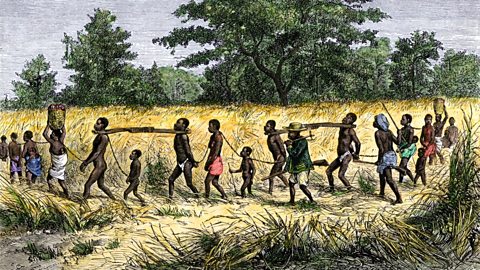 Image source, ALAMY
Image source, ALAMYMillions of Africans were directly affected by the trade in enslaved people.
- 18 million Africans were captured to be sold on as enslaved people.
- 6 million died either on the journey to the coast, in the fortresses along the coast waiting for the ships to arrive, or on board ships during the Middle Passage.
- 12 million were transported into slavery in the Caribbean or Americas.
Estimates suggest that 77 per cent of these enslaved people (10.1 million) were 'produced' along the west and west central coasts of Africa between 1701 and 1850. This is almost 10 per cent of the total population of the area.
The effect on West African societies was devastating. It lead to whole areas being underpopulated and underdeveloped for over a century.
 Image source, ALAMY
Image source, ALAMYWhat effect did the transatlantic trade have on agriculture in Africa?
The loss of millions of young African adults meant that there were fewer people available to grow and harvest crops and look after herds of animals.
Many farmers abandoned their land near the coast to avoid being captured. Instead, they moved further inland for their own safety. However, the quality of land often became poorer the further they moved inland. This meant that growing crops was more difficult and harvests were poorer.
The shortage of experienced farmers to pass on knowledge also meant that African agriculture did not develop and innovate in the same way it had elsewhere in the world.
As a result of all of this, famines were more common. This had a lasting effect on West African societies.
Effects of trade on West African societies
By the mid-18th century, enslaved people were Africa's main export.
- The trade in enslaved people represented as much as 95 per cent of the value of West Africa's exports.
- The price Europeans paid for enslaved people rose from ÂŁ3 per head in the 1680s to ÂŁ30 by 1800.
Aside from making traders of enslaved people and African leaders very rich, the transatlantic trade in enslaved Africans also had profound and lasting effects on West African societies.
The gun trade in West Africa
The mass introduction of firearms was the single most significant technological innovation brought by Europeans to West Africa.
- twenty million guns were imported to Africa in the second half of the 18th century.
- many guns were manufactured in Birmingham.
African rulers exchanged captives for guns. Rulers were in competition with each other, so the acquisition of guns gave them an advantage over their rivals.
This increased their drive to capture and sell enslaved people.
The mass importation of guns to trade for enslaved people altered the conduct of warfare in Africa and changed the balance of power between kingdoms.
At the height of the Atlantic trade, only states equipped with guns were able to resist attacks from their neighbours.
The demand for enslaved people, combined with the supply of guns, encouraged rulers to attack neighbours.
Africa's role in the trade in enslaved people
African slave sellers grew wealthy by selling captives to European traders on the coast. They were able to deal on equal terms with European traders.
On the African side, the trade in enslaved people was generally the business of rulers or wealthy and powerful merchants, concerned with their own personal interests.
At that time, there was no concept of being African – identity and loyalty were based on kinship or membership of a specific kingdom or society, rather than to the African continent.
In the long run, the scale of the Atlantic trade caused instability and rivalry between many African states.
Case study: the Kingdom of Dahomey
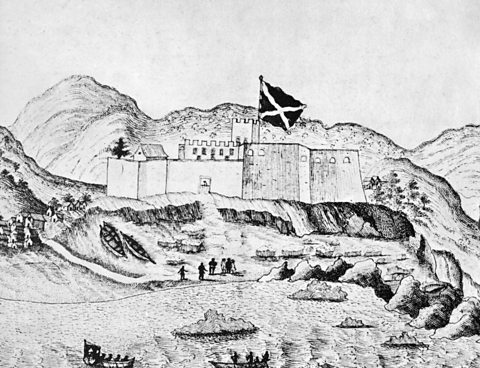 Image source, ALAMY
Image source, ALAMYThe Kingdom of Dahomey (now the modern nation of Benin) was another West African society that experienced the effects of slavery.
The Kings of Dahomey sent raiding parties into neighbouring lands with the sole purpose of capturing and enslaving people. These people would then be sold to the Europeans.
By 1750, King Tegbesu of Dahomey made £250,000 a year selling African people into slavery. With a high demand from Europeans for enslaved labour, slavery became the largest part of the Kingdom’s income.
The demand for enslaved people soon became so great that prisoners of war were not enough. Raiding parties were organised to kidnap young African people from rival societies.
It has been estimated that 326,000 enslaved people were taken from the Bight of Bonny (in modern-day Nigeria) between 1780 and 1800.
In 1790, Alexander Falconbridge, a slave-ship surgeon, reported that the goods used to buy enslaved people from this area included:
- guns
- gunpowder
- textiles
- iron bars
- brandy
Other popular items traded included copper, brass, and pewter goods.
Due to the trade in enslaved Africans, the area around the Bight of Benin and the Bight of Bonny became known as the Slave Coast.
 Image source, ALAMY
Image source, ALAMYAfrica and European racism
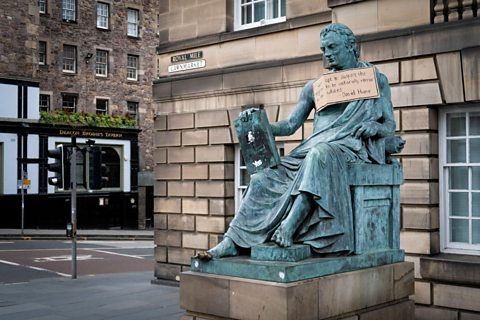 Image source, ALAMY
Image source, ALAMYThe loss of so many people also affected African culture.
Many African nations had amassed a great stock of scientific and cultural knowledge gathered over thousands of years. While, some of it was stored in libraries such as those of Timbuktu in Mali, much of it was passed down orally from generation to generation.
When millions of Africans were forcibly transported across the Atlantic, much of this knowledge was lost.
Arguably, the loss of this history has been one of the largest impacts the Atlantic trade in enslaved people has had on Africa.
It led some European philosophers to suggest that the nations of Africa had nothing to offer the wider world. The Scottish philosopher David Hume declared:
I am apt to suspect the [Africans] to be naturally inferior to the whites. There scarcely ever was a civilised nation of that complexion, nor even any individual, eminent either in action or in speculation. No ingenious manufacture among them, no arts, no sciences.
The view that those from the African nations were inferior was held by Europeans for several centuries afterwards.
 Image source, ALAMY
Image source, ALAMYTest what you have learned
Quiz
Recap what you have learned
- trade in enslaved Africans existed in Africa on a smaller scale before the arrival of Europeans
- European demand for slave labour turned the trade into a huge industry
- trade in enslaved people was profitable for Europeans and some African rulers and merchants
There was a huge human cost of the trade in enslaved African people:
- 12 million Africans transported into slavery in the New World
- 6 million Africans died in captivity and on board slave ships
There were wider social and cultural effects on Africa:
- loss of knowledge and history that was passed from person to person
- loss of farmers, poorer harvests and a lack of development in agriculture
- dismissive and racist European views of Africa and Africans developed
More on Trade in enslaved African people
Find out more by working through a topic
- count4 of 10

- count5 of 10

- count6 of 10
